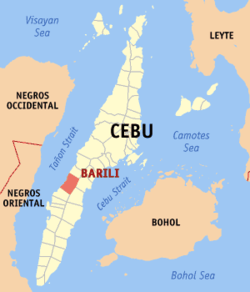Barili, Cebu
| Barili | |
|---|---|
| Municipality | |
|
Mantayupan Falls [1] | |
 Map of Cebu with Barili highlighted | |
.svg.png) Barili Location within the Philippines | |
| Coordinates: PH 10°07′N 123°31′E / 10.12°N 123.52°ECoordinates: PH 10°07′N 123°31′E / 10.12°N 123.52°E | |
| Country | Philippines |
| Region | Central Visayas (Region VII) |
| Province | Cebu |
| District | 3rd district of Cebu |
| Founded | 1632 |
| Barangay | 42 (see § Barangays) |
| Government [2] | |
| • Type | Sangguniang Bayan |
| • Mayor | Teresito Mariñas (LP) |
| • Vice mayor | Jose Nemeño |
| • Town Council |
Members
|
| Area [3] | |
| • Total | 122.21 km2 (47.19 sq mi) |
| Population (2010 census)[4] | |
| • Total | 65,524 |
| • Density | 540/km2 (1,400/sq mi) |
| • Voter (2013) [5] | 46,579 |
| Time zone | PST (UTC+8) |
| ZIP code | 6036 |
| IDD : area code | +63 (0)32 |
| Income class | 2nd class |
| PSGC | 072210000 |
Barili is a second income class municipality in the province of Cebu, Philippines.[3] According to the 2010 census, it has a population of 65,524.[4] In the 2013 election, it had 46,579 registered voters.[5]
Barili is located 61 km (38 mi) south-west of Cebu City. It marches to the south with Dumanjug; to the north with Aloguinsan; to the east with Carcar and Sibonga; and to the west lies the Tañon Strait. Its main tourist attraction is the Mantayupan Falls.[1]
Barangays
Barili comprises 42 barangays:[3]
- Azucena
- Bagakay
- Balao
- Bolocboloc
- Budbud
- Bugtong Kawayan
- Cabcaban
- Campangga
- Dakit
- Giloctog
- Guibuangan
- Giwanon
- Gunting
- Hilasgasan
- Japitan
- Cagay
- Kalubihan
- Kangdampas
- Candugay
- Luhod
- Lupo
- Luyo
- Maghanoy
- Maigang
- Malolos
- Mantalongon
- Mantayupan
- Mayana
- Minolos
- Nabunturan
- Nasipit
- Pancil
- Pangpang
- Paril
- Patupat
- Poblacion
- San Rafael
- Santa Ana
- Sayaw
- Tal-ot
- Tubod
- Vito
History
The word barili comes from the name of a local grass called balili. The municipality was founded in 1632, though the parish of Barili was established in 1614. A cross was erected by conquistadores on their arrival at 1602, and still exists today.
Demographics
| Population census of Barili | ||
|---|---|---|
| Year | Pop. | ±% p.a. |
| 1990 | 47,789 | — |
| 1995 | 52,060 | +1.62% |
| 2000 | 57,764 | +2.25% |
| 2007 | 60,430 | +0.62% |
| 2010 | 65,524 | +2.99% |
| Source: National Statistics Office[4][6] | ||
The population in 1903 was 31,617 persons.[7]
In the 2013 election, it had 46,579 registered voters, meaning that 71% of the population are aged 18 and over.[5]
Economy
The economic output of Barili is mainly rice, maize, bananas, vegetables and coconuts.
Tourism
Mantayupan Falls are located at 10°6′24″N 123°31′16″E / 10.10667°N 123.52111°E, close to the eastern end of the Carcar—Barili Road where it connects to the national highway. The falls are approximately 61 metres (200 ft) high but do not have a direct descent. Pools at various heights flow into the basin. The waterfall is one of three main tourist attractions in the interior barangays of Barili.[1][8]
References
- 1 2 3 4 Cabigas 2011.
- ↑ "Municipality". Quezon City, Philippines: Department of the Interior and Local Government. Retrieved 31 May 2013.
- 1 2 3 "Municipal: Barili, Cebu". PSA. Philippines: National Statistical Coordination Board. Retrieved 8 January 2016.
- 1 2 3 "Total Population by Province, City, Municipality and Barangay: as of May 1, 2010" (PDF). 2010 Census of Population and Housing. National Statistics Office. Retrieved 1 April 2013.
- 1 2 3 "2013 National and Local Elections Statistics" (PDF). Commission on Elections. 2015.
- ↑ "Population and Annual Growth Rates by Province, City and Municipality: Central Visayas: 1995, 2000 and 2007" (PDF). National Statistics Office. Archived from the original (PDF) on 24 June 2011.
- ↑
 Chisholm, Hugh, ed. (1911). "Barili". Encyclopædia Britannica (11th ed.). Cambridge University Press.
Chisholm, Hugh, ed. (1911). "Barili". Encyclopædia Britannica (11th ed.). Cambridge University Press. - ↑ Cebu.gov
Sources
- Cabigas, Estan (29 September 2011), "Visiting Mantayupan Falls after 23 years" (Photographic essay), Langyaw, archived from the original on 1 October 2011, retrieved 12 February 2015
- Pace, Azucena (2009). Barili The Town The People The Years, A History. Cebu: Local Government Unit of Barili, Cebu. ISBN 978-9719441601.
External links
| Wikimedia Commons has media related to Barili. |
 |
Aloguinsan | Carcar |  | |
| Tañon Strait | |
|||
| ||||
| | ||||
| Dumanjug | Sibonga |
| ||||||||||||||||||
